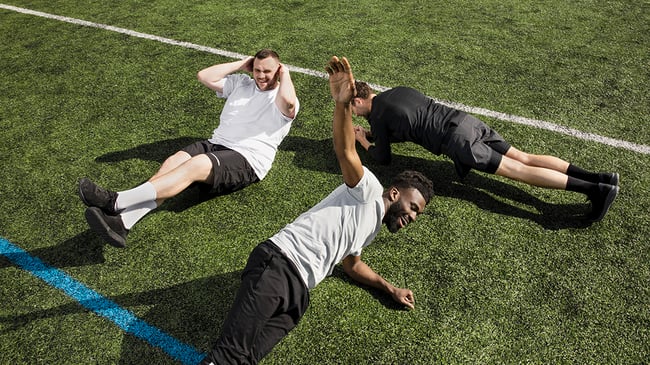

How to exercise in the heat
Photos Louis Canadas
Words Camille Claudet
Translated by Sébastien de Turenne
Share the article on
When even record-breaking temperatures can’t stop the gains.
You’re brave. Why? Because you’re one of the rare people whose motivation isn’t completely annihilated by extreme heat. Be careful, though: exercising in the summer requires caution as well as some adjustments. Read on for our tips to avoid overheating and keep on working out in the blistering heat.
Don’t let the heat get to you
Exertional heat stroke, also known as malignant hyperthermia of effort, is characterised by the athlete’s body reaching extremely high temperatures. When this temperature exceeds 40 °C, symptoms start to show, such as violent headaches, nausea and vomiting, and if things get worse, loss of consciousness or seizures. Very unpleasant, to say the least. Exertional heat stroke happens when your body is incapable of regulating its core temperature. Exercising by 30 °C or more could prove to be quite dangerous if you don’t follow certain precautions before and during your training session.
Do it, but do it right
Heatwaves make you sweat, nothing new there. It’s a natural process indicating that your body is shedding water to regulate its temperature. Exercising cranks it up a notch. It is therefore crucial for you to stay hydrated before, during, and after you train. While you’re exercising, you should drink water at least every 20 minutes.
Before you start working out, have a light snack - fruit, seeds or yogurt - to avoid feeling faint.
Also, make sure you’re wearing weather-appropriate gear. Light clothes, in cotton or any other breathable material, are what’s best for extremely high temperatures. Avoid synthetic materials at all costs, as they offer very poor breathability, and even tend to make you feel warmer.
To keep your body as cool as possible, remember to take regular breaks, or train early in the morning or late in the evening when the temperature is lower.
Beware of thermal shocks. Wait 20 minutes for your body temperature to decrease before hopping in a (well-deserved) cold shower.
Adapt your programme
In summer, go slower. Avoid anything too intense, such as tennis, football or running. Unless you’re fortunate enough to be able to train in a location with air conditioning, in which case, go for it.
Yoga, which requires effort to hold the poses, but nothing too violent, is particularly recommended in summer. Another of yoga’s benefits is that you can squeeze in a session anywhere, even on a paddle-board in the middle of the sea, although you might be tempted to fall in. However, if you’re a practitioner of Bikram yoga, which involves holding 26 poses in a 40 °C room, it’s best to avoid training between June and mid-September.
Walking, while less intense than running, is still an excellent way of gently toning your muscles, activating your blood flow, and reducing stress. Nothing like a good walk.
The Tour de France might inspire you to jump on a bike. Good idea, you’ll burn calories while putting most of your muscles to work. However, cycling under the summer sun does require not going too hard on the pedals, and never riding for more than 45 minutes at a time. Sorry, no full stage of the Tour de France for you.
Swimming, whether in a pool or open water, is obviously the go-to summer activity. It combines light effort and maximum freshness. Swimming builds muscles and improves your cardio. Just remember to enter the water slowly, thermal shock is no joke.
If you do feel that you’re up for something more intense, beach sports, such as beach volley and paddle tennis are great to get the blood flowing in your legs. Do remember to regularly go for a swim, though.
Long story short, this summer, take it easy.